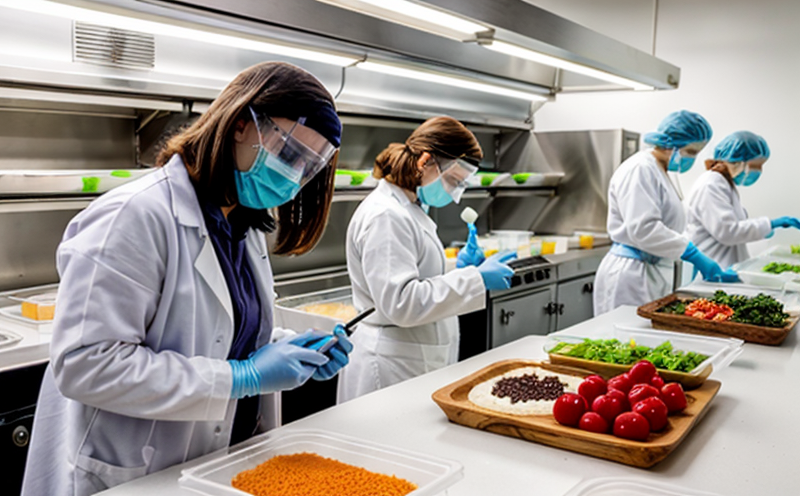AOAC 2007.04 Norovirus Detection Testing in Food
The AOAC International method 2007.04 is a standardized protocol designed to detect norovirus, a significant pathogen that can cause gastroenteritis and foodborne illness. This method is particularly crucial for the food industry where contamination with noroviruses poses serious health risks. Noroviruses are highly contagious and can survive in various environmental conditions, making them challenging to eliminate without rigorous testing.
The AOAC 2007.04 protocol involves the following steps: first, the specimen is prepared using a neutralization procedure that prevents the virus from replicating or mutating during processing. This step ensures accurate detection and reduces false positives. Subsequently, the sample undergoes reverse transcription (RT) to convert viral RNA into complementary DNA (cDNA). The cDNA is then amplified through quantitative real-time PCR (qPCR), allowing for precise quantification of norovirus particles present in the food matrix.
The method's sensitivity and specificity are critical for reliable results. The protocol is designed to detect as few as 10 genome copies per gram or milliliter, depending on the sample type. This level of detection ensures that even trace amounts of noroviruses can be identified, which is essential in maintaining food safety standards.
The AOAC 2007.04 method has been validated against international standards such as ISO and ASTM, ensuring its reliability across different laboratories and jurisdictions. Compliance with this protocol is not only a matter of quality control but also a legal requirement for many food manufacturers and suppliers worldwide.
Quality assurance in norovirus detection involves several key steps: first, the laboratory must maintain a clean and controlled environment to prevent cross-contamination. Secondly, the personnel handling the samples undergo rigorous training to ensure they follow standardized protocols accurately. Additionally, regular calibration of instruments used in the testing process is vital for obtaining consistent results.
The AOAC 2007.04 method also contributes significantly to environmental sustainability by promoting safer food production and reducing the risk of outbreaks. By detecting noroviruses early, manufacturers can implement corrective actions promptly, minimizing the spread of contamination. This proactive approach not only protects public health but also enhances consumer confidence in food products.
In conclusion, AOAC 2007.04 Norovirus Detection Testing in Food is a critical process that ensures the safety and quality of food products. By adhering to this protocol, food manufacturers can maintain compliance with international standards, protect public health, and build trust among consumers.
Quality and Reliability Assurance
- Maintains a clean and controlled environment in the laboratory to prevent cross-contamination.
- Trained personnel follow standardized protocols accurately.
- Regular calibration of instruments used in the testing process.
- Strict adherence to international standards such as ISO and ASTM.
The AOAC 2007.04 protocol is designed to ensure that even trace amounts of noroviruses can be identified, which is essential for maintaining food safety standards. By adhering to this protocol, laboratories can provide reliable results that are consistent across different environments and jurisdictions.
Environmental and Sustainability Contributions
- Reduces the risk of norovirus outbreaks by detecting pathogens early.
- Promotes safer food production practices.
- Enhances consumer confidence in food products.
- Supports compliance with international standards, ensuring a level playing field for all producers.
The AOAC 2007.04 method is not only crucial for the food industry but also plays a significant role in environmental sustainability. By minimizing the risk of norovirus contamination, this protocol helps protect public health and enhances consumer trust in food products. This proactive approach to quality control ensures that even trace amounts of pathogens are detected, contributing to safer and more reliable food production practices.
Competitive Advantage and Market Impact
The AOAC 2007.04 Norovirus Detection Testing in Food offers several competitive advantages for businesses operating within the food industry. By ensuring that noroviruses are detected early, manufacturers can implement corrective actions promptly, minimizing the spread of contamination. This proactive approach not only protects public health but also enhances consumer confidence in their products.
Compliance with international standards such as ISO and ASTM is a legal requirement for many food manufacturers and suppliers worldwide. By adhering to these protocols, businesses can demonstrate their commitment to quality control and safety, which can be a significant differentiator in the market. This ensures that even trace amounts of noroviruses are detected, contributing to safer and more reliable food production practices.
In addition, the AOAC 2007.04 method supports compliance with international standards, ensuring a level playing field for all producers. By maintaining high-quality testing protocols, businesses can build trust among consumers and regulators alike, which is crucial in today's competitive market environment.





